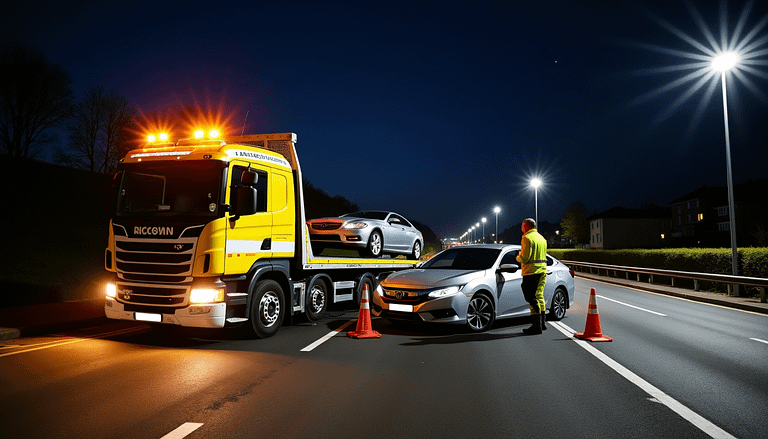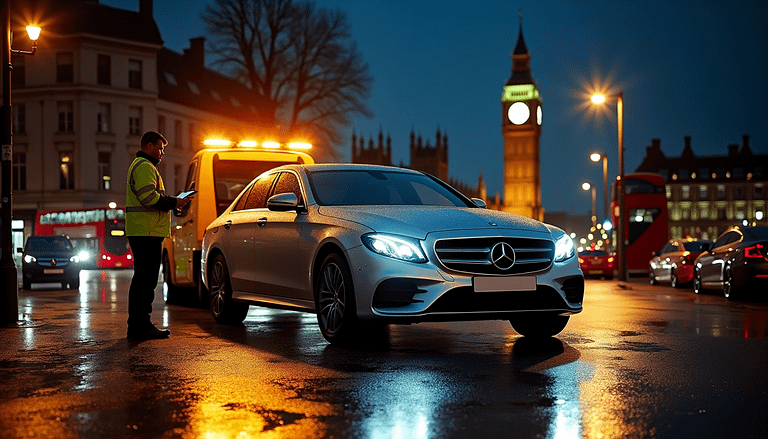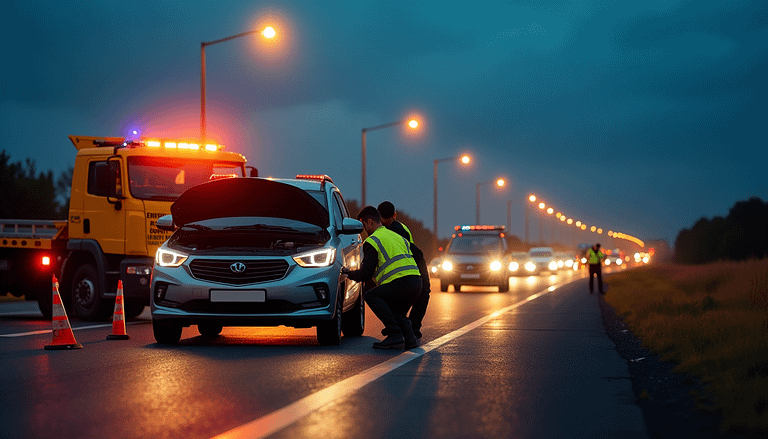What to Do During an Emergency Breakdown: A Driver’s Survival Guide (2025)
Dead batteries cause most emergency breakdown calls, especially when winter temperatures affect performance. Recent data reveals that all but one of these drivers managed without recovery services, but every motorist should be ready for unexpected breakdowns.
The right breakdown cover can speed up your emergency response time. Top providers reach stranded drivers in under 30 minutes, but some services make their customers wait more than two hours. About 150,000 UK drivers deal with misfuelling problems each year, so you need to know exactly what to do when trouble hits.
This piece will show you the quickest way to handle an emergency breakdown safely. You’ll learn everything you need to stay prepared for any roadside emergency.
Immediate Safety Protocols During Breakdown
Proper Vehicle Positioning and Hazard Signals
Stay calm when you notice mechanical issues. Move your vehicle to a safe location, ideally off the road or onto a hard shoulder . Switch your hazard warning lights on right away to let other drivers know you’re there . Turn your wheels to the left if you’re on the motorway to keep maximum distance from passing traffic .
Personal Safety Steps and Exit Procedures
After positioning safely, you should only get out through the left-hand door . Put on a high-visibility jacket if you have one before stepping out . Get well away from your car and moving traffic – at least 45 meters (147 feet) behind your vehicle . Make sure all passengers follow these safety steps, but keep any animals inside the vehicle .
Emergency Services Communication Guidelines
Modern vehicles with eCall systems will contact emergency services automatically if airbags deploy. Cars without this feature should use the emergency roadside phones where possible, as these link directly to highway control centers . Face the traffic to stay aware of approaching vehicles while talking to emergency services . Your mobile phone works too – just look for the blue rectangular Driver Location Signs that show your exact position .
The most important thing to remember: stay in your vehicle with seatbelts fastened and call 999 right away if you’re stuck in a live traffic lane or feel in danger. People with disabilities who can’t follow standard exit steps should stay in their vehicle with hazard lights on and contact emergency services immediately.
Essential Emergency Response Steps
Assessing the Breakdown Situation
Your vehicle’s condition needs a quick review once you’re safe. Check for obvious problems like flat tires, engine troubles, or electrical failures. Any warning lights or unusual sounds before the breakdown can help identify the issue.
Contacting the Best Breakdown Cover Service
You should reach out to your breakdown provider right away. Keep your membership number, vehicle’s make, model, registration number, and exact location ready . Modern breakdown services now accept what3words coordinates to find you faster .
Documentation and Evidence Collection
Good documentation is vital for insurance claims and breakdown coverage. Your roadside assistance report must include:
- Entity details of service provider
- Date, time, and location of incident
- Specific breakdown circumstances and vehicle condition
Clear photographs of your vehicle’s position and visible damage help a lot. Save all receipts and invoices if you changed a tire or made emergency repairs. Serious incidents need witness contact information from people at the scene.
Your breakdown provider needs these details to verify the incident and process claims quickly, so keep copies of all breakdown-related documents. These records might help with future claims or vehicle service history.
Smart Technology Solutions for Breakdowns
Modern technology has changed how drivers deal with emergency breakdowns. Today’s breakdown assistance providers use sophisticated mobile apps to streamline the rescue process.
Using Emergency Assist Apps and Features
Drivers can now report breakdowns through dedicated mobile apps instead of making phone calls. These apps come with several essential features:

- GPS location tracking for precise positioning
- Up-to-the-minute recovery vehicle tracking
- Push notifications for arrival updates
- Digital documentation of breakdown details
- Instant allocation of recovery operators
These apps work remarkably well. Recovery operators get assigned within 20 seconds after someone reports a breakdown.
Digital Safety Tools and Resources
Digital alerting systems help prevent roadside accidents effectively. Advanced warning technology reduces collision risks between emergency vehicles and other drivers by 90% . These systems send electronic alerts to drivers through navigation apps and vehicle infotainment systems.
Connected Car Emergency Features
Modern connected cars pack advanced safety features that traditional vehicles lack. The eCall system, which European vehicles must have since 2018, automatically alerts emergency services during accidents. This technology makes emergency responses 40% faster in urban areas and 50% faster in rural areas. It could save 2,500 lives each year.
Smart emergency access systems add extra layers of safety to enhance driver protection. First responders can access vehicles even when electronic systems fail or batteries die. Connected vehicles also send critical data packages that improve emergency response by sharing details about crash severity and vehicle location.
Vehicle-Specific Emergency Procedures
Vehicle breakdown procedures vary based on your car’s powertrain and technology level. Let’s look at the key procedures for different types of vehicles.
Electric and Hybrid Vehicle Considerations
Electric and hybrid vehicles work with high-voltage systems that range from 60 to 1500 volts DC. These vehicles need special care during breakdowns. First responders must wear protective equipment because these vehicles create unique hazards from their battery systems and electrical parts.
Critical Safety Protocol:
- Check for orange high-voltage cables and warning labels
- Look for signs of battery damage or coolant leaks
- Stay clear of any hissing or popping sounds from the battery
- Maintain at least 15 meters distance if thermal runaway is suspected
Electric vehicle batteries can release toxic gasses, mostly hydrogen fluoride, during thermal events. Submerged electric vehicles need extra caution, though their high-voltage systems usually stay isolated from the chassis .
Modern Safety System Management
Advanced driver assistance systems (ADAS) make a big difference during breakdowns. These systems, like electronic stability control, prevent up to one-third of all road accidents. Modern vehicles now come with sophisticated safety features that need proper handling during emergencies.
The tridion safety cell, found in many modern vehicles, gives better protection by wrapping around passengers like a hard shell. Crash sensors turn on hazard warning lights automatically after impact, which helps other motorists see the vehicle clearly .
Special Considerations for Smart Cars
Smart vehicles come with extra emergency response features. The emergency call (e-Call) system contacts rescue services automatically when airbags deploy. This cuts response times by 40% in urban areas and 50% in rural locations.
Smart cars with the Premium Connectivity Package can be tracked if stolen. Modern smart cars scored highest in Safety Assist during 2023 testing. They offer better protection through advanced body structures and non-thermal-propagation battery technology.
Conclusion
Quick thinking and proper preparation are what you just need for roadside emergencies. This piece taught us that safety comes first – from correct vehicle positioning to using modern tech for quicker help. Smart technology has reshaped the scene of breakdown assistance and saves thousands of lives each year by cutting response times by a lot.
Emergency responses vary based on your vehicle type. Electric vehicles must be handled specially, while smart cars come with built-in safety features that make breakdowns easier to manage. Whatever type of vehicle you drive, proper documentation and quick communication with emergency services are crucial.
Your best defense against roadside emergencies is preparation. Now is the perfect time to Get a Quote for complete breakdown coverage that protects you when the unexpected happens. Only 12% of drivers used recovery services last year, but those who stayed prepared handled their emergencies better.
Modern technology and proper preparation make breakdowns easier to handle when you follow safety protocols. These guidelines help you navigate emergency situations with confidence and keep everyone safe until help arrives.
FAQs
Q1. What are the immediate steps to take during a vehicle breakdown?
First, safely move your vehicle off the road or onto the hard shoulder. Turn on your hazard lights, exit through the left-hand door, and move at least 45 meters behind your vehicle. If you have one, wear a high-visibility jacket for added safety.
Q2. How can I use technology to assist during a breakdown?
Many breakdown service providers now offer mobile apps that allow you to report your breakdown, share your precise location, and track the arrival of assistance. These apps can significantly speed up the rescue process, with some assigning recovery operators in as little as 20 seconds.
Q3. What special precautions should I take if my electric or hybrid vehicle breaks down?
For electric or hybrid vehicles, maintain a safe distance from the vehicle, especially if you suspect battery damage. Look out for orange high-voltage cables and warning labels. If you hear hissing or popping sounds from the battery, stay at least 15 meters away and wait for professional assistance.
Q4. How do I communicate my location effectively to emergency services?
If your vehicle isn’t equipped with an automatic eCall system, use roadside emergency phones where available. When using a mobile phone, reference the blue rectangular Driver Location Signs for your exact position. Some services also accept what3words coordinates for precise location sharing.
Q5. What documentation should I gather during a breakdown incident?
Collect a detailed roadside assistance report including the service provider’s details, date, time, location, and specific breakdown circumstances. Take clear photographs of your vehicle’s position and any visible damage. Keep all receipts for any emergency repairs or services, as these may be needed for insurance claims or breakdown coverage.





